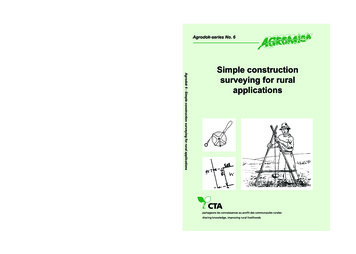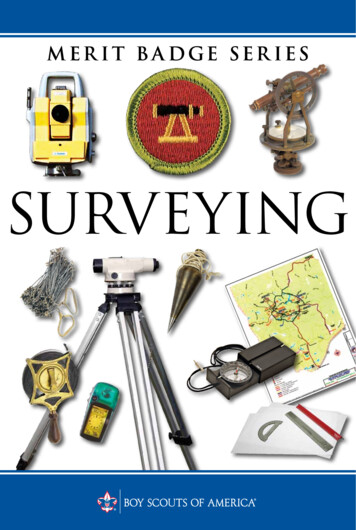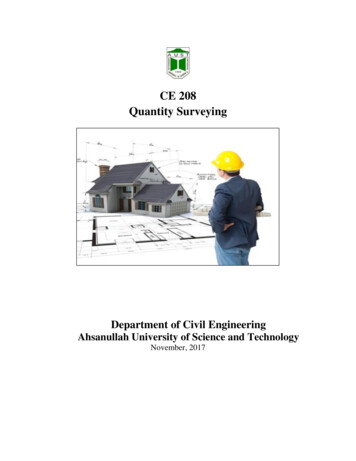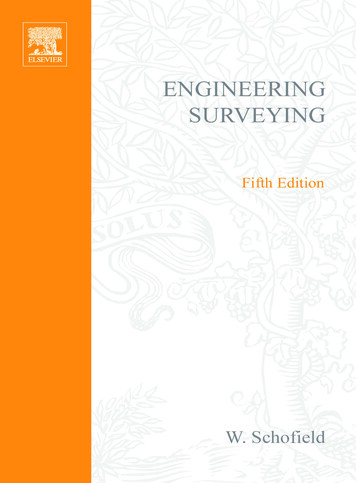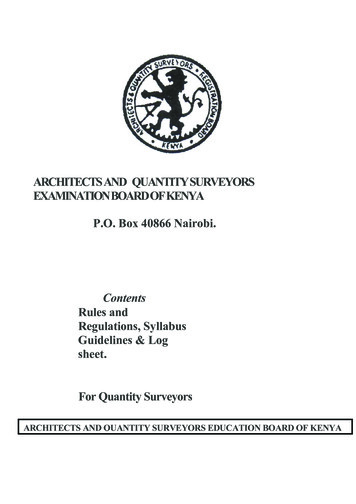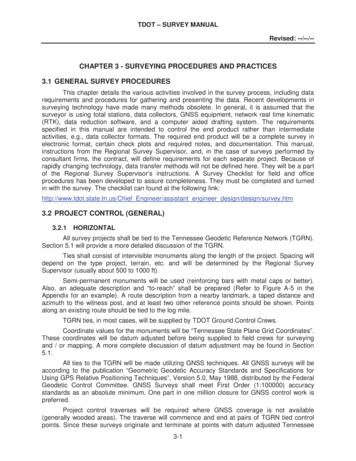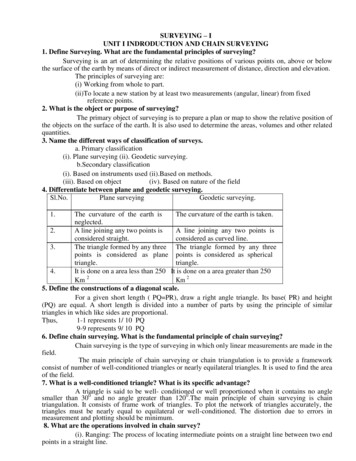
Transcription
SURVEYING – IUNIT I INDRODUCTION AND CHAIN SURVEYING1. Define Surveying. What are the fundamental principles of surveying?Surveying is an art of determining the relative positions of various points on, above or belowthe surface of the earth by means of direct or indirect measurement of distance, direction and elevation.The principles of surveying are:(i) Working from whole to part.(ii)To locate a new station by at least two measurements (angular, linear) from fixedreference points.2. What is the object or purpose of surveying?The primary object of surveying is to prepare a plan or map to show the relative position ofthe objects on the surface of the earth. It is also used to determine the areas, volumes and other relatedquantities.3. Name the different ways of classification of surveys.a. Primary classification(i). Plane surveying (ii). Geodetic surveying.b.Secondary classification(i). Based on instruments used (ii).Based on methods.(iii). Based on object(iv). Based on nature of the field4. Differentiate between plane and geodetic surveying.Sl.No.Plane surveyingGeodetic surveying.1.The curvature of the earth isThe curvature of the earth is taken.neglected.2.A line joining any two points isA line joining any two points isconsidered straight.considered as curved line.3.The triangle formed by any three The triangle formed by any threepoints is considered as plane points is considered as sphericaltriangle.triangle.4.It is done on a area less than 250 It is done on a area greater than 250Km 2Km 25. Define the constructions of a diagonal scale.For a given short length ( PQ PR), draw a right angle triangle. Its base( PR) and height(PQ) are equal. A short length is divided into a number of parts by using the principle of similartriangles in which like sides are proportional.Thus,1-1 represents 1/ 10 PQ9-9 represents 9/ 10 PQ6. Define chain surveying. What is the fundamental principle of chain surveying?Chain surveying is the type of surveying in which only linear measurements are made in thefield.The main principle of chain surveying or chain triangulation is to provide a frameworkconsist of number of well-conditioned triangles or nearly equilateral triangles. It is used to find the areaof the field.7. What is a well-conditioned triangle? What is its specific advantage?A triangle is said to be well- conditioned or well proportioned when it contains no anglesmaller than 300 and no angle greater than 1200.The main principle of chain surveying is chaintriangulation. It consists of frame work of triangles. To plot the network of triangles accurately, thetriangles must be nearly equal to equilateral or well-conditioned. The distortion due to errors inmeasurement and plotting should be minimum.8. What are the operations involved in chain survey?(i). Ranging: The process of locating intermediate points on a straight line between two endpoints in a straight line.
(ii). Chaining: The process of measuring the distance with a chain or tape.(iii). Offsetting: The process of measuring the lateral distance of the object from the surveyline to the left or right according to their positions.9. What are the instruments required for a chain survey?Chain or tape, Arrows, Pegs, Ranging rods, Offset rods, Laths or whites, Plumb bob, Crossstaff and Mallet.10. Write the different types of Chain.(i). Metric chain(ii). Non-Metric chain(a).Gunter‟s chain or Surveyor‟s chain (b). Engineer‟s chain (c). Revenue chain (d). Steel band.11. Differentiate between Gunter’s chain and Engineer’s ChainSl.No.Gunter‟s chain or Surveyor‟s chainEngineer‟s chain1.It is 66 feet long and divided in to 100It is 100 feet long and divided inlinks. 1link 0.66 feetto 100 links. 1link 1 feet2.Measurements are in miles and furlongs.Measurements are in feet anddecimals12. Define the terms:(a).Main stations: Main station is a prominent point on the chain line and can be either at thebeginning of the chain line or at the end or along the boundary.(b). Subsidiary stations: The stations located on the main survey lines are known as Subsidiarystations.(c). Tie stations: These are also subsidiary stations taken on the main survey lines to locate the detailsof the object.13. Distinguish between a check line and a tie line.Sl.NoCheck lineTie line1.Check lines or Proof lines are theThe main object of running a tie linelines which are run in the field tois to take the details of the objects.check the accuracy of the work2.The length of the check lineTie line is a line which jointsmeasured in the field must agreesubsidiary stations or tie stations onWith its length of the plan.the main line.14. What are the instruments used for setting out right angles to a chain line?(i). Cross staff.a. Open cross staff b.French cross staff c.Adjustable cross staff(ii). Optical square (iii). Prism square (iv). Site square.15. What are offsets? Classify them.An offset is the lateral distance of an object or ground feature measured from a survey line.The two types of offsets are,(i). Perpendicular offset: The angle of offset from a point on a chain line is 900(ii). Oblique offset: When the angle of offset is other than 900 .Perpendicular offsetOblique offset16. What is the use of a line Ranger?The line Ranger is a small reflecting instrument used for fixing intermediate points on thechain lines. Without going to either end, we can fix the intermediate points.17. What are the different sources of errors in chain surveying?(i). Instrumental errors: incorrect length of the chain (Cumulative Errors).
18. What are the stages of fieldwork in chain surveying? Or what are the steps involved in chainsurvey? Reconnaissance: It is the preliminary inspection of the area to be surveyed. Marking and fixing Survey lines. Running survey lines. Taking Offsets.19. What are the different tape corrections? Correction for absolute length or standardisation. Correction for temperature. Correction for pull or tension. Correction for sag. (- ve) Correction for slope. (- ve)20. What are the errors in chaining?(i). Compensating Errors: Which are liable to occur in either direction and tend tocompensate.(ii). Cumulative Errors: Which occur in the same direction and tend to add or subtract. Itmay be positive (measured lengths more than the actual length) or negative (measured lengths less thanthe actual length).(iii). Personal error: Bad ranging (Cumulative Errors). Careless holding (CompensatingErrors). Bad straightening (Cumulative Errors). Non- horizontality (Cumulative Errors). Sag in chain(Cumulative Errors). Miscounting and misreading and booking.(iv). Natural Errors: Variation in temperature. (Cumulative Errors).21. Enumerate the instruments used for measurement of lengths of survey lines.(i). Chain or tape. (ii)Passometer. iii). Pedometer (iv). Odometern (v). Speedometer.UNIT IICOMPASS SURVEYING AND PLANE TABLE SURVEYING1. Define: Compass surveying. What are the objects of compass surveying?Compass surveying is the type of surveying in which the direction of the survey lines aremeasured with a compass and the length of the survey lines are measured with a tape or chain in thefield.2. Write the names of the instruments used in chain surveying.(i). Instruments for the direct measurement of directions:a) Surveyor‟s compass. b). Prismatic compass.(ii).Instruments for the measurement of angles: a) Sextant b) Theodolite.3. Define the terms:(a). True meridian and bearing:True meridian:The line or plane passing through the geographical North Pole, South Pole and any pointon the surface of the earth, is known as true meridian or geographical meridian. True meridian at apoint is constant.True bearing:The angle between the true meridian and a survey line is known as true bearing or Azimuthof the line.(b). Magnetic meridian and Bearing:Magnetic meridian :Magnetic meridian at a point is the direction indicated by freely suspended, properlybalanced and unaffected magnetic needle at that point.Magnetic Bearing:The angle between the magnetic meridian and a survey line is known as magnetic bearingor bearing .of the line. It changes with time.
4. What do you understand by Whole circle bearing and quadrantal bearing of a line?Magnetic Bearings are designated by Whole circle bearing system and quadrantal bearingsystem.In Whole circle bearing system (WCB), the bearing of the line is measured with magneticnorth in clockwise direction. It varies from 00 to 3600.In quadrantal bearing system (Q.B or R.B) the bearing of the line is measured eastward orwestward from north or south, whichever is nearer. The directions can be either clockwise oranticlockwise. It varies from 00 to 900.5. Convertthe whole circle bearing into reduced bearing: 500, 1760, 2100, 2320, 1500, 760, 31000,242 .Whole circle bearingWCBReduced bearingRB500N 500 E.1760S (1800 – 1760)E S 40 E2100S (2100 – 1800)W S 300 W2320S (2320 – 1800)W S 520 W1500S (1800 – 1500) E S 300 E760N 760 E3100N (3600 – 3100) W N 50 0 W2420S (2420 – 1800)W S 620 W6.What is its back bearing?In quadrantal bearing (RB) system, the FB and BB are numerically equal but the quadrantsare just opposite.The FB of a line PQ is N 280 W, Then its BB is S 280 E .7. Differentiate between Prismatic compass and Surveyor’s compass with reference to readingand tripod.SI.No. ItemPrismatic compassSurveyor‟s compass1.Reading(i). The reading is taken with a(i). The reading is taken byhelp of prism provided at the eye directly seeing through the top ofslit.the glass.(ii). Sighting and reading taking(ii). Sighting and reading takingcan be done simultaneously from cannot be done simultaneouslyone position of the observer.from one position of theobserver.2.TripodTripod may or may not beThe instrument cannot be usedprovided.without a tripod.8. Define: Fore and Back bearing.The bearing of a line is measured in the direction of the progress of the survey is called thefore bearing of the (FB) line.The bearing of a line is measured in the direction opposite to the survey is called the backbearing of the (BB) line.
BB FB 180 0 . (FB greater than 180 0, use - sign) (FB smaller than 180 0, use sign)9. The fore bearing of line AB is 155025’20”. Identify the back bearing of the line AB inquadrantal system.The fore bearing of line AB 155025‟20”. The back bearing of line AB , BB FB 180 0 1550025‟20” 180 0 335 25‟20”(WCB) N (3600 – 335025‟20”) W N 24034‟ 40‟‟ W 10. Define and distinguish between magnetic dip and magnetic declination.Magnetic dip:Due to the magnetic influence of the earth, the needle does not remain in the balancedposition. This inclination of the needle with the horizontal is known as the dip of the magnetic needle.To balance the dip of the needle, a rider (brass or silver coil) is provided along with it.Magnetic declination:The magnetic meridian of a place is variable one due to some local attractive forces.Therefore, the true meridian and the magnetic meridian at a place do not coincide. The horizontal anglebetween the magnetic meridian and the true meridian is known as magnetic declination.11. The magnetic0 bearing of a0 line is 48024’. Calculate the true bearing if the magneticdeclinations are 5 38’ East and 5 38’ West.True bearing Magnetic bearing Eastern magnetic declination 480024‟ 5038‟ 54 02‟.True bearing Magnetic bearing - Western magnetic declination 48024‟ - 5038‟ 42046‟.12. The magnetic bearing of a line is S 28030’ E. Calculate the true bearing if the magneticdeclinations are 5038’ East and 50 38’ West.Convert the reduced bearing into Whole circle bearing.Magnetic bearing S 280030‟ 0E. (RB) 1800 - 2830‟ 151 300 .True bearing Magnetic bearing Eastern magnetic declination 1510030‟ 7030‟ 159 00‟.(WCB) S(1800-159000‟)E (RB) S 21 0 ETrue bearing Magnetic bearing - Western magnetic declination 1510030‟ - 7030‟ 144 00‟.(WCB) S(1800-144000‟)E (RB) S 36 0 E.13. What is local attraction? What are the sources of local attractions?Local attraction is a term used to denote any influence, such as magnetic substances, whichprevents the needle from pointing to the magnetic north in a given locality.The sources of local attractions are : magnetite in the ground, wire carrying electriccurrent, steel structures, rails, underground iron pipes, chain etc.,14. Distinguish between closed traverse and open traverse.SI.No.Closed traverseOpen traverse1.When the lines form a circuit, whichIf the circuit ends elsewhere, it isends at the starting point, it is knownKnown as open traverse.as closed traverse.2.It is suitable for locating theIt is suitable for surveying a long narrow stripboundaries of lakes, woods etc,.of land required for road canal etc,.
3.Check:Sum of interior angles (2n – 4) 90Sum of exterior angles (2n 4) 90Where, n number of sides of thetraverse.No direct check on angularmeasurements.15. What is plane table surveying? When is it preferred? Write its principle.Plane tabling is the graphical method of surveying in which the field observations andplotting proceed simultaneously.It is mainly suitable for filling the interior details between the control stations and also inmagnetic areas.The main principle of plane table surveying is that the lines joining the points on the planetable are made to lie parallel to the corresponding lines joining the points on the ground while workingat each station.16. Name four methods of plane surveying.i) Radiation ii) Intersection. iii) Traversing iv) Resection.(i). Resection after orientation by compass.(ii). Resection after orientation by back sighting.(iii). Resection after orientation by three point problem.a. Mechanical method.(Tracing paper method)b. Graphical method. ( Bessel‟s method)c. Lehman‟s method. (Trial and error method) (iv). Resectionafter orientation by two point problem17. When a three- point problem resorted to in plane table surveying?It is the method of orientation when the table occupies a position not yet located on thedrawing sheet.This method is employed when during surveying the surveyor feels that some importantdetails can be plotted easily by choosing any stations.18. State the First and second Lehman’s rule.First rule: The distance of the point “p” (position of plane table on the drawing sheet) to befixed from each rays Aa (paper a, to ground A), Bb (paper ,b to ground B) and Cc (paper c, to groundC) is proportional to the respective distances of the stations A, B and C from the ground station P.Second rule: While looking towards the stations the point “p” to be fixed, will be either tothe left or to the right of each of the rays.19. What are the Advantages of plane table surveying?1. It is useful in magnetic areas.2. It is cheaper than the theodolite surveying.3. It is most suitable for small-scale maps.4. The surveyor can compare plotted work with the actual features.5. No skill is required .20. Name some of the errors in plane tabling.1. Instrumental error.2. Errors of plotting3. Errors due to manipulation and sighting.1. Non horizontality of the board.2. Defective sighting.3. Defective orientation.4. Movement of board between sights.
UNIT IIILEVELLING AND APPLICATIONS1. Define Levelling. What are the uses of leveling?Levelling is a branch of surveying, the object of which is; (i). To find the elevations ofgiven points with respect to a given or assumed datum, and (ii). To establish points at a givenelevation or at different elevations with respect to a given or assumed datum.2. Define benchmark and reduced level.Benchmark:Benchmark is a relatively permanent point of reference whose elevation with respect tosome assumed datum is known.Reduced level or Elevation:The vertical distance of a point above or below the datum is known as the elevation orR.L of that point. R.L of a point may be positive or negative according as the point is above or belowthe datum.3. What are the different kinds of bench marks?A BM is the reference point of known elevation. It may be classified into following types.(i).G.T.S Bench Mark: The great trigonometrical survey (G.T.S) bench marks areestablished by the survey of India throughout the country. The levels of this bench marks areestablished very accurately at a large interval with respect to the mean sea level at Bombay port.(ii). Permanent Bench Mark: These are established by different Government departmentslike PWD, Railways, Irrigation etc,. The RL of these points are determined with reference to the G.T.SBench Marks. Points on rocks, culvert, gate pillars, etc,.(iii).Temporary Bench Mark: These are established temporarily whenever required. Theseare generally chosen to close the day‟s work and to start the next days. Points on roofs, walls,basements, etc,.(iv). Arbitrary Bench Mark: When the RL of some fixed points are assumed, they aretermed arbitrary benchmark.4. What do you mean by datum surface?It is any surface, to which elevations are taken as a reference for the determination ofelevations of various points. In India the datum adopted for the great trigonometrical survey (G.T.S) isthe mean sea level at Bombay port.5. What is mean by line of collimation and height of collimation?Line of collimation (Line of sight): It is an imaginary line passing through the intersection of the crosshairs at the diaphragm and the optical centre of the object glass and its continuation.Height of collimation(HOC): The elevation of the Line of collimation (Line of sight) is known asHeight of collimation. HOC RL of BM BS.6. Write the different types of levels.1. Dumpy level2. Tilting level3. Quick setting level.4. Y-level.5. Reversible level.6. Automatic level7. Lazer level.7. List the essential parts of a Level.Telescope, Eyepiece, ObjectiveFocusing screws. Longitudinal bubbleFoot screws, Upper parallel plate ( Tribrach), Foot plate( Trivet).Diaphragm adjusting screws, Bubble adjusting screws, Tripod.
8. What are the different type’s leveling staffs?1. Target Staff2. Self reading Staff.a. Solid Staffb. Folding Staffc. Telescopic Staff.9. Define and distinguish between ‘Back sights’ and ‘Fore sight’ in the process of fly Levelling.SI.No Back sights (BS)Fore sight (FS)1.This is the first staff reading takenThis is the last staff readingin any setup of the instrument. It istaken in any setup of thealways taken on a point of knowninstrumentand,afterthatelevation( BM).instrument is shifted.2.It is used to determine the heightIt is used to determine theof the instrument.elevation (RL) of the staffHI known RL BSstation.RL HI – FS.10. What is the theory of direct leveling?It is the branch of leveling in which the vertical distances with respect to a horizontalline may be used to determine the relative difference in elevation between two adjacent points. Stepsinvolved:HI known RL(BM) BS RL HI – FS.11. Distinguish between differential levelling and reciprocal levelling.SI.No.Differential levellingReciprocal levelling1.Difference in elevation between Difference in elevation between twotwo or more points is determined points is accurately determined byby without any regard to thetwo sets of reciprocal observations.alignment of the points is calleddifferential leveling.2.It is used when:It is used when:(i). two points are a large(i). The instrument cannot be setupdistance apart.between the two points due to an(ii). The difference in elevation obstruction such as a valley, river,between two points is large.etc,.(iii). Some obstacles intervenesbetween the points.12. Reduced level of Bench Mark A- 50.000mReading on staff held at A- 2.435mReading on staff held at station point B- 1.650mFind: (a) Height of collimation.(b) Reduced level of station point B.c) Rise/fall of B with respect to A.(a). Height of collimation RL of BM A BS(HOC) 50.000 2.435 52.435m(b) Reduced level of station point B. HOC – FS. 52.435 - 1.650 50.785 m( c). Rise/fall of B with respect to A. 2.435- 1.65 ( Lower staff reading being higher) 0.785m, with compare to A, the station point B being 0.785m higher.
13. Compare height of collimation method and rise and fall method.SI.NoHeight of collimation methodRise and fall method1.2.3.4.5.It is more rapid, less tedious andsimpler as it involves few calculation.There is no check on the RL of theintermediate points.Errors in intermediate RL‟s cannot bedetected.There are two arithmetic checks onthe accuracy of RL calculation. BS - FS Last RL –First RL.It is suitable in the case of L.S andC.S, Contour etc.It is more laborious and tedious ,involving several calculations.There is a check on the RL of theintermediate points.Errors in intermediate RL‟s can bedetected.There are three arithmetic checkson the accuracy of RL calculation. BS - FS Rise - Fall LastRL –First RL.It is suitable in fly leveling where Iintermediate sights are less.14. Write the formula for curvature correction, refraction correction and combinedcorrection.Curvaturecorrection CC 0.07849 d2 ( negative) m Refraction2correction Cr 0.011212d (positive) m Combined correction. C CC – Cr 0.06728 d (negative) m.Note: „d‟ is to be substituted in Km, while the corrections will be in m.15. List out the various sources of errors in leveling.Three principal sources:(i). Instrumental errora. Error due to imperfect adjustmentb. Error due to sluggish bubble.c. Error due to movement of objective slide.d. Error due to defective joint.e. Error due to incorrect length of staff.(ii). Natural error.a. Earth‟s curvature.b. Atmospheric refraction.c. Variations in temperature.d. Settlement of tripod.e. Wind vibrations.(iii). Personal errors.a. Mistakes in manipulation.b. Mistake in staff handlingc. Mistake in reading the staff.d. Error‟s in sighting.e. Mistakes in recording.16. List out the leveling problems.1. Levelling on Steep Slope.2. Levelling on Summits and Hollows. 3.TakingLevel of an Overhead Point.4. Levelling Ponds and Lakes too Wide to be Sighted across.5. Levelling across River.6. Levelling on Past High Wall.17. Define sensitivity of a bubble. State any two factors affecting the same.The sensitiveness of a bubble is defined the angular value of one division of the bubbletube. It means the capability of showing small angular movements of the tube vertically. It can beincreased by:
1. Increasing the internal radius of the tube.2. Increasing the diameter of the tube.3. Increasing the length of the tube.4. Decreasing the roughness of the walls.5. Decreasing the viscosity of the liquid.18. What is a spire test?It is used to make the horizontal axis perpendicular to the vertical axis. This test is alsoknown as the test for the adjustments of the standards. It is done by means of the adjustments of thevertical hair. It is one of the permanent adjustment of the level and theodolite.19. Define Contour, contour interval and, horizontal equivalent.Contour: A contour is an imaginary line on the ground joining the points of equalelevation.Contour interval: It is the vertical distance between any two consecutive contours. Itdepends upon the nature of the ground, the scale of the map and the purpose of the survey.Horizontal equivalent: It is the horizontal distance between any two consecutivecontours. It varies according to the steepness of the ground.20. What are the different Characteristics of contour?1. Contour lines are closed curves. They may either within the map itself or outside themap depending upon the topography.2. Uniformly spaced, contour lines indicate a uniform slope.3. A series of closed contours with increase in elevation from outside to inside in plandenotes a hill.4. A series of closed contours with increase in elevation from inside to outside in plandenotes a depression.5. The spacing between the contour lines depends upon the slope of the ground. Insteep slopes, the spacing is small and for gentle slope, the spacing is large.21. What are the uses of contours?1. Volume of earthwork for any work can be estimated.2. The capacity of the reservoir or the area of the catchments can be calculated.3. Very useful in military operations to decide the position of the guns, the line of March.4. Longitudinal and cross section can be drawn along any direction to know the nature ofthe ground.22. Write the different formulae to calculate the area of the irregular plate.1. By computations based directly on the field measurements:(i). By dividing the area into number of triangles. (ii). By offsets tobase line.a.Mid ordinate rule O .db.Average ordinate Rule nd. O n 1c.Trapezoidal rule ( Oo On Ol O2 O3 On-1) d 2d.Simpson‟s rule [( Oo On ) 4( O1 O3 . On-1) 2( O2 O4 .On-2 ) ] (d/3)Oo Ordinate at one end. On Ordinate at other end.Ol O2 O3 On-1 Ordinate at end of each divison. d Length of the base(iii). By latitudes and Departures:a. By double meridian distance (D.M.D. method).b. By double parallel distance (D.P.D. method). (iv). Byco- ordinates.2. By computations based on measurements scaled from a map.3. By mechanical method: By means of planimeter.
23. How do you calculate the capacity of the reservoir from the contour map?From the contour map, the capacity of the reservoir is calculated by the followingformulas.1. Trapezoidal rule ( Ao An Al A2 A3 An-1)2. Prismoidal rule [( Ao An ) 4( A1 A3 . An-1) 2( A2 A4 . An-2 ) ] (d/3)Ao, A1, A2, A3, An Areas enclosed by successive contours. d contour interval.UNIT IVTHEODOLITE SURVEYING1.Define: Theodolite surveying. What are the uses of a theodolite?Theodolite surveying is a branch of surveying, in which the theodolite is accurateinstrument used for the measurement of horizontal angles, vertical angles. It can also be used forvarious purposes such as laying off horizontal angles, locating points on a line, prolonging surveylines, establishing grades, determining differences in elevation, etc,.2. Why a type of theodolite is called a transit theodolite?A transit theodolite is one is which the line of sight can be reversed by revolving thetelescope through 1800 in the vertical plane.3. List the essential parts of a theodolite.The telescope, The vertical circle, The index frame (T- frame), The levelling head, Thescale plate (Lower), The Vernier plate (Upper). The tripod, Plumb bob, The compass,Focusing screws,The upper and lower clamp and its tangential screws, Vertical clampscrew, Foot screws. etc,.4. Differentiate between the Vernier theodolite and Micrometer theodolite.In Vernier theodolite the verniers are fitted to read the angles upto 20”. InMicrometer theodolite micrometers are fitted to read the angles.5. List the essential qualities of a theodolite telescope.The essential parts of the telescope:(i).Objective (ii).Eye-piece, (iii). Diaphragm, (iv). Body and focusing device.The essential qualities of a theodolite telescope:(i). The real image must be formed in front of the eye-piece.(ii). The plane of the image must coincide with that of the cross-hairs.6. What are the temporary adjustments of the theodolite?1. Setting up.2. Levelling up.3. Elimination of parallax.(i). Focusing the eye piece. (ii).Focusing the Objective.7.List out the permanent adjustments of Theodolite.1. Adjustment of plate level (Plate level test).2. Adjustment of line of sight ( Cross- hair test).3. Adjustment of horizontal axis.(Spire test).4. Adjustment of vertical index frame and altitude bubble. (Vertical arc test).8. List out the fundamental lines of Theodolite1. The vertical axis 2.The horizontal axis or trunnion axis2. The line of collimation or line of sight. 4. Axis of plate level.5. Axis of altitude level.9. What is an anallatic lens? What is the use of an anallatic lens?It is a special convex lens fitted between the object glass and eye piece, at a fixeddistance from the object glass, inside the telescope of a tacheometer.The use of an anallatic lens is to reduce the additive constant (C) to zero. Tacheometric
equation, D Ks C. Where, D horizontal distance between the staff and the instrument station.S staff intercept, K multiplying constant. C additive constant.10. Name the two methods of measuring horizontal angles using a theodolite. When eachmethod is advantageously used?The two methods: (i). Repetition method.(ii). Reiteration method (Direct method).The method of repetition is preferred for the measurement of a single angle. Themethod of reiteration is preferred in triangulation, where a number of angles may berequired at one point by the instrument.The method of repetition appears to be better, it is more time consuming and evenmany repetitions may yield ordinary results.11. State what errors are eliminated by repetition method.1. Errors due to imperfect eccentricity of verniers and centers‟ are eliminated byreading both verniers and taking the mean of the reading.2. Errors due to imperfect adjustment of the instrument are eliminated by taking faceleft and right observations.3. Errors due to inaccurate graduations on the main scale are eliminated as the readingsare spread over different parts of the circle.4. Errors due to inaccurate bisection of the signal are eliminated, as they tend tobalance each other. All the errors are also minimized as the number of repetitions divides the sum.12. What are the methods used to plot the traverse? By parallel Meridians through Each Station. By Included Angles By Paper Protractor. By rectangular co-ordinates. Plotting by tangents and chords.13.Define closing error.If a closed traverse is plotted according to the field measurements, the end point of thetraverse will not coincide exactly with the starting point, due to the errors in the field observations.Such as error is known as closing error.Closing error e ( L) 2 ( D) 2.where, L sum of latitudes. D sum of departures.The direction of closing errortan θ D / L.14. Define: Balancing. What are the methods used to balancing the traverse?The term balancing is generally applied to the operation of applying corrections tolatitudes and departures. So that L sum of latitudes 0; D sum of departures 0. This isapplied only for c
6 . Define chain surveying. What is the fundamental principle of chain surveying? Chain surveying is the type of surveying in which only linear measurements are made in the field. The main principle of chain surveying or chain triangulation is to provide a framework consist of number of well-conditioned triangles or nearly equilateral triangles.
